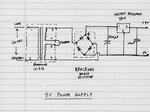vanchopski
Newbie level 4
I'll just let everyone here know first off that I'm a complete rookie at electronics which is exactly why I'm here requesting help with what for you folks is likely a simple project design.
I'm desinging a prototype device that I hope will improve the performance of a kitchen appliance. The prototype includes a microprocessor that controls both the appliance and an external device.
I'm hoping to be able to power the microprocessor and the device both from the appliance's power supply.
- the microprocessor requires 5 VDC @ 1A but has an onboard regulator that can handle up to 12 VDC
- the external device requires 12 VDC at 25 mA
I found a schematic that supplies 9 VDC from 120 VAC input and I was wondering if it could be easily modified to supply 12 VDC @ 1A.
Info on the main components:
- Hammond 161D12 transformer, Series output 12.6 VAC @ 70mA, Parallel output 6.3 VAC @ 140 mA
- B80C800G bridge rectifier, https://pdf1.alldatasheet.com/datasheet-pdf/view/61892/GE/B80C800G.html
- 7809 voltage regulator, **broken link removed**
Can anyone explain what would have to be altered with this design?
I'm desinging a prototype device that I hope will improve the performance of a kitchen appliance. The prototype includes a microprocessor that controls both the appliance and an external device.
I'm hoping to be able to power the microprocessor and the device both from the appliance's power supply.
- the microprocessor requires 5 VDC @ 1A but has an onboard regulator that can handle up to 12 VDC
- the external device requires 12 VDC at 25 mA
I found a schematic that supplies 9 VDC from 120 VAC input and I was wondering if it could be easily modified to supply 12 VDC @ 1A.
Info on the main components:
- Hammond 161D12 transformer, Series output 12.6 VAC @ 70mA, Parallel output 6.3 VAC @ 140 mA
- B80C800G bridge rectifier, https://pdf1.alldatasheet.com/datasheet-pdf/view/61892/GE/B80C800G.html
- 7809 voltage regulator, **broken link removed**
Can anyone explain what would have to be altered with this design?
